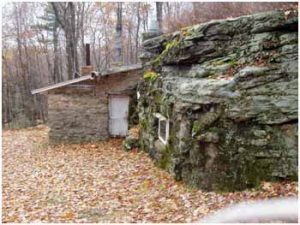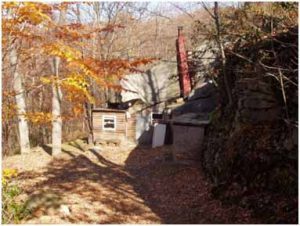Unique Hunting Camps of Bennett's Valley
Contributed by Jim Burke
Prior to the arrival of the first white settlers to the Bennett’s Valley area, the Seneca Indians considered this area as one of their favorite hunting grounds because of the abundance of wildlife here. When John Bennett came to the Bennett’s Branch in the late 1700’s he built a number of cabins along the branch, one of these cabins was located in Caledonia, and it was claimed that there were a series of beaver dams from Caledonia all the way to the headwaters. At one time, wolves, panthers, mountain lions, catamounts, and native Pennsylvania elk roamed the forest of the Bennett’s Valley. Eels were also abundant in the Bennett’s Branch. Brook’s, an early settler, in the Driftwood area claimed he could catch enough fish in twenty minutes to feed his family for a week.
By the early 1900’s the settlers had severally diminished the elk and deer populations, causing a need for hunting regulations and the establishment of the Pennsylvania Game Commission. The Game Commission efforts in expanding, particularly the deer and elk herds proved to be very successful. In 1906 the Commission imported Michigan Deer and thus developing a larger deer than was here when the pioneers first arrived.
The deer herd rapidly expanded, and in 1920 the Game Commission purchased 6,288 acres of land that was open for public hunting. The Bennett’s Valley area became a deer hunter paradise. Deer hunters from all over the Commonwealth and surrounding states came to the valley to hunt the whitetails. Many hunters at that time came by railroad.
As a result of the influx of deer hunters in the early 1920s many hunting cabins sprung-up throughout the Valley, particularly in the Medix Run, Caledonia, Benezette, Dents Run and Hick Runs areas. One of the earliest hunting camps was the Trout Run Lodge established by Andrew Kaul in the headwaters of Trout Run in 1888. Mr. Kaul had the Michigan Deer imported. This Lodge has had a continuous deer hunt since it was first establish until 2008.

Medix Run's Stone Cave Camp

Stone Camp in Spring Run
The Medix Run Stone Cave Camp and the Wolfic Run Stone Camp are considered by many as the two most unique camps in the area. Both of these camps were first used in the early 1920’s, and are still being used today as hunting camps.
Remember that when visiting these camps that they private camps still in use today. Leave nothing but footprints, take only pictures.
Directions to Medix Run’s Stone Cave Camp. From Medix Run proceed on the Quehanna Road until you come to the Grant Trail Road intersection located on the left hand side of the Quehanna Road on top of the mountain. Proceed on the Grant Trail Road approximately .6 miles to the Barr Hollow Road; continue on the Barr Hollow Road approximately 1.6 miles until you came to state marker # 1691. This road is the driveway to the Stone Cave Camp.
Directions to the Stone Camp in Spring Run. Coming from Byrendale on Route 255, turn right on the Spring Run Road. Follow the Spring Run to the intersection of Spring Run Road and Burke Road. At this intersection go straight, do not turn on Burke Road. Follow this camp road until you come to the Wolfic Run foot bridge. Here you cross the stream and following the road to the end of the strip mining reclamation. From this point follow the first camp road to the left. This will take you to the Stone Camp that overlooks the valley into Little Wolfic.